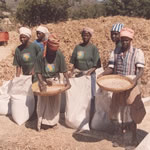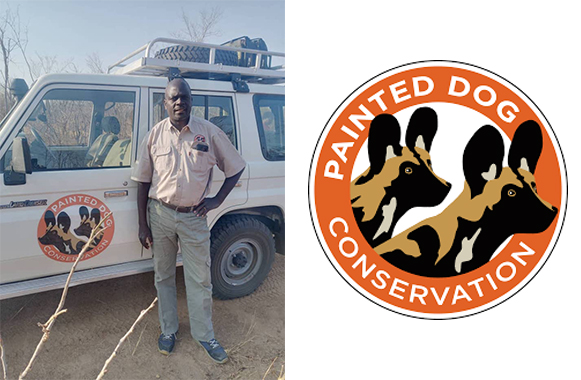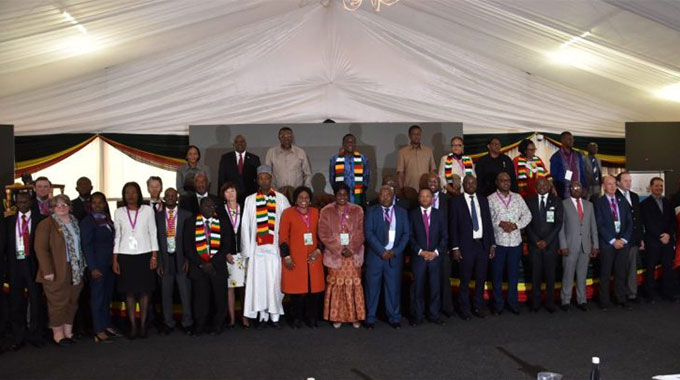Soyabeans: There’s more to it than cash

players and experts in the soya bean industry descending on Harare to jointly search for a panacea to the challenges confronting their industry.
The meeting, the second for the Southern Africa Soybean Association, came at a time when there is steep demand for soya products that is even projected to double in the next decade.
In his address to stakeholders attending the meeting, TechnoServe project manager Mr Niraj Varia said the objective was to try and develop a multi-country strategic soya bean roadmap and outline the current potential of both smallholder and commercial producers to get the best out of them.
“A robust soya bean sector will spur development in the livestock sector, especially for poultry while improving human consumption too.
“When used in a rotation with maize, soya beans improve maize yields by 10 percent through fixation of nitrogen into the soil,” he said.
He said the region needed a sustainable soya bean alliance to boost production and also needed to identify key policymakers and organisations responsible for providing marketing information and the planning of free trade in the region.
“Free trade should involve such blocks as Comesa, ACTESA, Sadc and SACAU to reduce transaction costs and improve reliability of the marketing structures.
“It is also vital to train personnel involved in stocks, trade in flows and maintain strategic and fast track planning required in certification and harmonisation of soya trade for the next five years if soya hectarage is to be increased by 237 percent in the region,” he said.
Soya yields for the entire Southern Africa region currently stand at 861 kilo metric tonnes (KMT) against a demand for 2 million metric tonnes.
South Africa produces 588KMT on 311 000ha, Mozambique 18KMT, Angola 15KMT, Zambia 112KMT on 62 000ha while Zimbabwe is at 50 KMT on 67 000ha to single out a few.
Zimbabwe is projected to require 272 000MT of soya beans by 2020 while the hectarage is also expected to expand to 164 000ha to adequately meet the growing demand.
The country’s soya demand currently outstrips production, with demand at 125KMT per annum and production at 50KMT per year.
At the moment, Zimbabwe is importing soya products like oil from South Africa, beans and cake from Zambia, beans from Malawi and (recently) cake from India.
“The growth of Zimbabwe’s livestock sector (especially poultry and fish, driven by low cost of and preference for white protein over beef, continued presence of large producers and shorter financing cycle) is being constrained by the lack of fluent supply of soya meal,” he added.
Soya production fell from 17KMT in 2001 due to the decline in commercial farming and general lack of financing and agronomic training though traders are increasingly witnessing a trend in which smallholders are substituting soya for maize because of the current high prices.
Previously, commercial farmers produced 90 percent of soya while smallholders produced 10 percent but the trend has since changed to 65 percent for the former and 35 percent for the latter.
“Farmers in Zimbabwe are educated and sophisticated and can farm soya effectively given credit, inputs and training.
“But while private investment is unlikely to return in sufficient amounts to finance soya production in the near future, financing could be provided by industry players through a contract farming model that would also provide an avenue for the transfer of skills,” said Mr Varia.
Stakeholders at the meeting agreed in principle that there was potential to increase the incomes of 35 000 smallholder farmers by US$138 per year while increased growth of the sector would also enable faster growth of the livestock and processing industries creating additional jobs in the sectors.
At the moment, Zimbabwe only produces 30 percent of its soya demand yet there is considerable scope for growth of production that is sometimes at the mercy of very unreliable energy infrastructure associated with endless outages rendering irrigation unreliable.
Among the plethora of problems rocking the soya industry, communication has also emerged as one of the key issues that will enable the industry to recover fast if revitalised.
Currently there are 354 000 telephones, 1,7 million mobile phones, 1,4 million Internet users, 19 airports, two ports (Binga and Kariba) 97 000km of roadways (of which 80 percent is not paved) and 3 000km of railway. Zimbabwe has the advantage of good road infrastructure and a good transport industry that can be used in the revival of the soya industry.
It currently imports 70 percent of its soya products while 65 percent of its production comes from the commercial farmers.
“Most of the land in Zimbabwe is suitable for soya growing but the best is in regions 1 and 2, which is a positive for the industry’s ambitious drive to wake up from its current slumber,” a soil scientist with the University of Zimbabwe, Professor Sheunesu Mpepereki commented.
He further cited lack of developmental finances, co-ordination at regional level and the general lack of information on educational demonstrations as some of the factors killing soya production.
“Asia and South America have a deliberate policy to invest in soya production while there is no such thing in Africa. We definitely need that.
“At the moment research in soya production the world over seems to be focussing on GMO produced soya at the expense of the non-GMO, which is killing production seriously. GMOs are known to improve the quality and disease resistance of soya beans but not yields,” he said.
The underlying fact, however, is that the soya industry in the region is currently reeling from a severe lack of liquidity in the financial systems that has seen most key operations failing to take off or doing so at minimal to moderate levels.
Southern Africa has a vision of seeing the over 200 000 smallholder soya producers improving from the average yields of 0,5 tonnes per hectare to 2 t/ha while the commercials move from the current average of 1,8t/ha to 3t/ha by 2020.
However, only commercial farmers with yields above 3t/ha consistently make a profit from soya, a feat only possible with those using irrigation.
Soya production is only profitable to the smallholder on cash cost basis but not when value of labour is included.
The crop has the advantage of being a low cash input crop with a ready market. It is difficult to steal and helps restore soil nutrients.
In South Africa, soyabean, like maize is used in the production of biodiesel in addition to making cooking oil.
Soya is quite a profitable crop with the best farmers making US$214 per metric tonne at the current prices but the redeeming factor is that the estimated beginning of season for a metric tonne will be US$400.
[email protected]







Comments